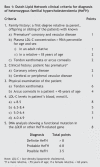Heterozygous familial hypercholesterolemia: an underrecognized cause of early cardiovascular disease
- PMID: 16606962
- PMCID: PMC1421462
- DOI: 10.1503/cmaj.051313
Heterozygous familial hypercholesterolemia: an underrecognized cause of early cardiovascular disease
Abstract
Heterozygous familial hypercholesterolemia (HeFH) is a monogenic disorder that affects about 1 in 500 people, with a higher prevalence in certain subpopulations such as people of Quebecois, Christian Lebanese and Dutch South Afrikaner extraction. HeFH is characterized by cholesterol deposits affecting the corneas, eyelids and extensor tendons; elevated plasma concentrations of low-density lipoprotein (LDL) cholesterol; and accelerated vascular disease, especially coronary artery disease (CAD). Although HeFH is genetically heterogeneous, it is most often caused by heterozygous mutations in the LDLR gene encoding the LDL receptor. We describe a man who was diagnosed with HeFH after he had a myocardial infarction at 33 years of age. By DNA sequence analysis, he was found to have a heterozygous splicing mutation in his LDLR gene. This discovery expanded the growing mutational spectrum in patients with HeFH in Ontario. Given that HeFH is a treatable cause of early vascular disease, it is important that this condition be recognized, diagnosed and treated in affected patients; but as yet, there is no consensus on the best approach. Diagnostic criteria based on family history and clinical presentation have been proposed for patients with suspected HeFH. Biochemical or molecular screening might be considered to detect new cases of HeFH in populations with a relatively high HeFH prevalence and a relatively small number of possible causative mutations. So far, however, the most cost-effective and efficient systematic strategy to detect previously undiagnosed cases of HeFH is still cascade testing: clinical and biochemical screening of close relatives of the proband patient diagnosed with HeFH. Pharmacologic treatment of HeFH is cost-effective.
Figures



Similar articles
-
Coronary computed tomographic angiographic findings in asymptomatic patients with heterozygous familial hypercholesterolemia and null allele low-density lipoprotein receptor mutations.Am J Cardiol. 2013 Apr 1;111(7):955-61. doi: 10.1016/j.amjcard.2012.12.012. Epub 2013 Jan 19. Am J Cardiol. 2013. PMID: 23340035
-
The molecular genetic basis and diagnosis of familial hypercholesterolemia in Denmark.Dan Med Bull. 2002 Nov;49(4):318-45. Dan Med Bull. 2002. PMID: 12553167 Review.
-
Differences in phenotype, genotype and cardiovascular events between patients with probable and definite heterozygous familial hypercholesterolemia.Per Med. 2019 Nov;16(6):467-478. doi: 10.2217/pme-2018-0135. Epub 2019 Nov 6. Per Med. 2019. PMID: 31691639
-
The detection of heterozygous familial hypercholesterolemia in Ireland.Adv Ther. 2012 May;29(5):456-63. doi: 10.1007/s12325-012-0021-0. Epub 2012 May 17. Adv Ther. 2012. PMID: 22610724
-
[Heterozygous familial hypercholesterolemia].Turk Kardiyol Dern Ars. 2014 Oct;42 Suppl 2:10-8. Turk Kardiyol Dern Ars. 2014. PMID: 25693359 Review. Turkish.
Cited by
-
No significant improvement of cardiovascular disease risk indicators by a lifestyle intervention in people with familial hypercholesterolemia compared to usual care: results of a randomised controlled trial.BMC Res Notes. 2012 Jul 4;5:181. doi: 10.1186/1756-0500-5-181. BMC Res Notes. 2012. PMID: 22490761 Free PMC article. Clinical Trial.
-
Reply: Pseudoexfoliation syndrome and cardiovascular disease: studies must control for all cardiovascular risk factors.Eye (Lond). 2013 Nov;27(11):1329. doi: 10.1038/eye.2013.185. Epub 2013 Aug 23. Eye (Lond). 2013. PMID: 23970026 Free PMC article. No abstract available.
-
Alternative cascade-testing protocols for identifying and managing patients with familial hypercholesterolaemia: systematic reviews, qualitative study and cost-effectiveness analysis.Health Technol Assess. 2023 Oct;27(16):1-140. doi: 10.3310/CTMD0148. Health Technol Assess. 2023. PMID: 37924278 Free PMC article.
-
Familial hypercholesterolemia and the atherosclerotic disease.Korean Circ J. 2013 Jun;43(6):363-7. doi: 10.4070/kcj.2013.43.6.363. Korean Circ J. 2013. PMID: 23882283 Free PMC article.
-
A tailored lifestyle intervention to reduce the cardiovascular disease risk of individuals with Familial Hypercholesterolemia (FH): design of the PRO-FIT randomised controlled trial.BMC Public Health. 2010 Feb 15;10:69. doi: 10.1186/1471-2458-10-69. BMC Public Health. 2010. PMID: 20156339 Free PMC article. Clinical Trial.
References
-
- Brown MS, Goldstein JL. A receptor-mediated pathway for cholesterol homeostasis. Science 1986;232:34-47. - PubMed
-
- Word Health Organization—Human Genetics (editors). DoNDP, familial hypercholesterolaemia: report of a second WHO Consultation. Geneva: WHO; 1999.
-
- Kuch B, Bolte HD, Hoermann A, et al. What is the real hospital mortality from acute myocardial infarction? Eur Heart J 2002;23:714-20. - PubMed
-
- Rosamond WD, Chamblesss LE, Folsom AR, et al. Trends in the incidence of myocardial infarction and in mortality due to coronary heart disease, 1987 to 1994. N Engl J Med 1998;339:861-7. - PubMed
-
- Takada D, Emi M, Ezura Y, et al. Interaction between the LDL-receptor gene bearing a novel mutation and a variant in the apolipoprotein A-II promoter: molecular study in a 1135-member familial hypercholesterolemia kindred. J Hum Genet 2002; 47:656-64. - PubMed
Publication types
MeSH terms
LinkOut - more resources
Full Text Sources
Medical
Miscellaneous
